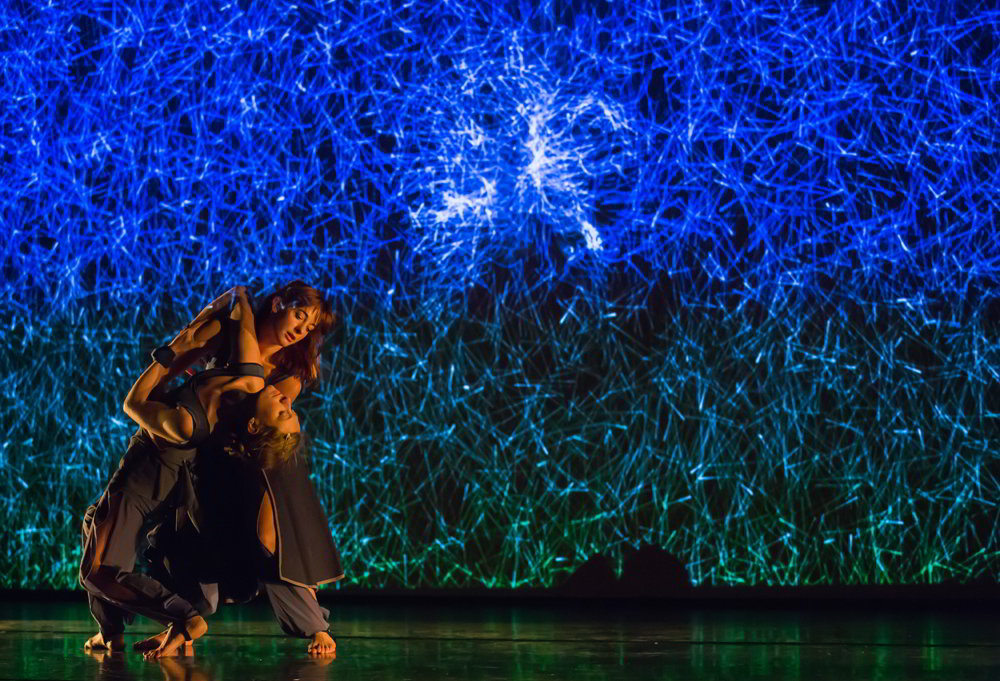People have always asked me how dance fitted in with my research on art and science. For a long time I kept my eyes open for an example of dance interacting with science in such a way that both are advanced. I found it in danceroom Spectroscopy (dS) masterminded by David Glowacki, a dynamic theoretical chemist, artist, inventor and cultural theorist at the University of Bristol.
Based on a research platform he had put together for molecular dynamics, Glowacki headed a team of scientists, artists and engineers who came up with a digital dance performance called Hidden Fields. Hidden Fields combines cutting-edge interactive digital art with rigorous molecular dynamics. This extraordinary performance has dancers, computers and physics playing off one another by transforming dancers’ movements into energy fields that create disturbances in simulations of molecular dynamics. In this way 21st century science and technology offer a unique glimpse into the beauty of our everyday movements.
Glowacki describes Hidden Fields in some detail:
When the physicist Richard Feynman was asked to sum up the most important scientific knowledge we possess, he said: ‘Everything is made of atoms.’
danceroom Spectroscopy (dS) is a new award-winning atomic visualisation that helps us to imagine the beautiful atomic world, and our connection to it. dS is built from rigorous computational physics and state-of-the-art computing, and relies on many of the same theories and equations that research scientists use to model the atomic world. Dreamed up by Royal Society Research Fellow Dr. David Glowacki, dS combines real-time high-performance computing, 3d capture, electronic music, and digital art. It’s part video game, part art installation, part immersive science visualisation, and part molecular research platform.
Through a unique collaboration between a talented group of scientists, artists, and engineers, dS has been used to construct a multi-award winning digital dance performance called Hidden Fields, which interprets dancers as fields whose movement creates ripples and waves in an invisible sea of energy. The result is a gentle piece comprised of interactive graphics and soundscapes, both of which respond in real-time to how the dancers use their movement to sculpt the invisible fields in which they are embedded. Hidden Fields offers a unique and subtle glimpse into the beauty of our everyday movements, allowing us to imagine how we interact with the hidden energy matrix and the atomic world – which forms the fabric of nature but is beyond our perceptions. It’s as much a next-generation dance piece as it is an invitation to contemplate emergence, dissipation, and the interconnected dynamism of the natural world – from the microscopic to the cosmic.
(Support for dS and Hidden Fields come from the Royal Society, the University of Bristol, Arts Council England, the UK Engineering and Physics Research Council, NVIDIA, Stanford Arts Institute, the Watershed Digital Media Centre, the Royal Society of Chemistry, and the University of the West of England.)
The beauty of Hidden Fields reveals itself in the following photographs and two stunning videos:
(Images & video courtesy of danceroom Spectroscopy. For a full contributor list see www.danceroom-spec.com/people.)
Hidden Fields turned out to be more than a dance-science performance. Its super-fast algorithms – created for dance – have led to new avenues in scientific research including a means for users to interactively manipulate protein molecular dynamics in real time in ways that are 10,000 times as fast as brute-force structure-finding algorithms.
At present, Glowacki and his team are investigating methods for deploying this platform on a larger scale in order to crowd-source some of the most fundamental problems in chemical dynamics and structure prediction. This is an unexpected outcome of scientific & artistic creativity fused into one.
(For technical details see: D. R. Glowacki et al., “A GPU-accelerated immersive audiovisual framework for interactive molecular dynamics using consumer depth sensors,” Faraday Discussions 169, doi: 10.1039/C4FD00008K)

